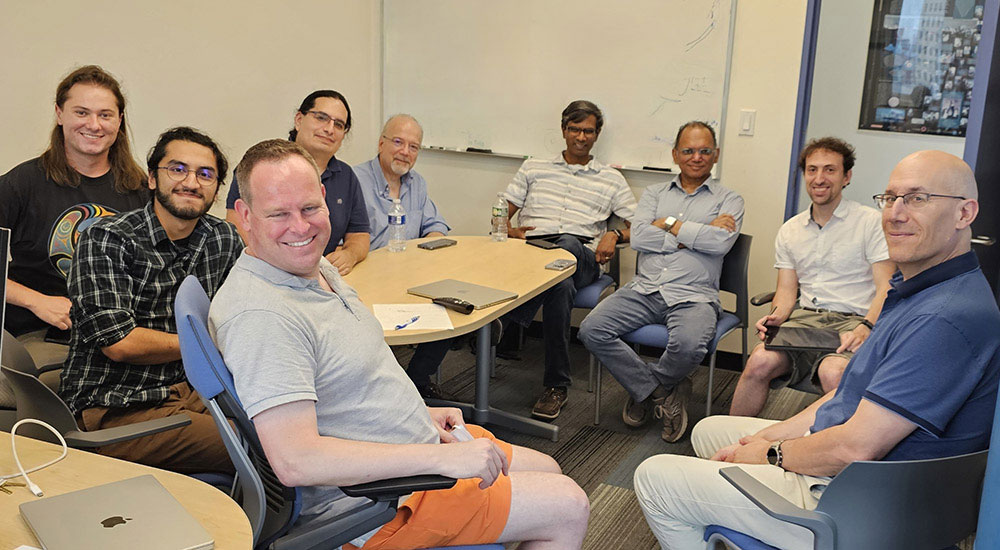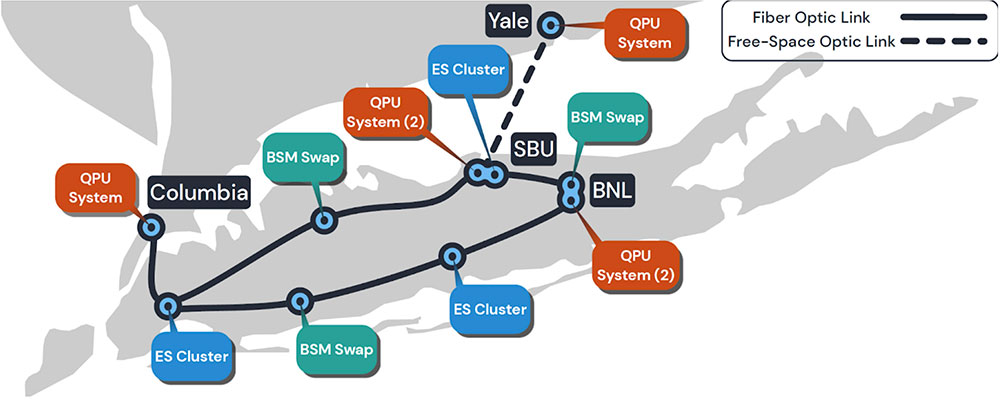SBU Collaboration to Lead Project in National Quantum Virtual Laboratory Program
August 9, 2024
 enlarge
enlarge
The SCY-QNet NQVL team (right to left): Alex Gaeta (Columbia), John Drogo (Columbia), Himanshu Gupta (Stony Brook), C.R. Ramakrishnan (Stony Brook), Dimitrios Katramatos (BNL), Eden Figueroa (Stony Brook), Sebastian Will (Columbia), Anthony Del Valle (Stony Brook) and Chase Wallace (Stony Brook).
Editor’s note: The following feature story was published today by Stony Brook University. Lead researcher Eden Figueroa is a joint appointee at Brookhaven National Laboratory. Brookhaven Laboratory is a key contributor to the pilot project just selected for the National Quantum Virtual Laboratory (NQVL), which is funded by the U.S. National Science Foundation (NSF). For more information on Brookhaven’s involvement, contact Danielle Roedel (droedel@bnl.gov).
In a landmark achievement for quantum science, Stony Brook University, in collaboration with Columbia University, Yale University and Brookhaven National Laboratory, has been chosen to lead a project in the competitive National Quantum Virtual Laboratory (NQVL) program. This initiative, funded by the U.S. National Science Foundation (U.S. NSF), marks a pivotal moment in advancing Quantum Information Science and Technology (QIST) in the United States.
Led by PI Eden Figueroa, Stony Brook Presidential Innovation Endowed Professor and director of the Center for Distributed Quantum Processing, the team’s proposal, NQVL:QSTD: Pilot: Wide-Area Quantum Network To Demonstrate Quantum Advantage (SCY-QNet), targets to design and implement a 10-node quantum network connecting state of the art laboratories at Stony Brook University, Brookhaven National Laboratory, Columbia University, and Yale University, creating the Stony Brook-Columbia-Yale Quantum Network (SCY-QNet).
This ambitious project seeks to create a 10-node entanglement distribution quantum network linking laboratories across these renowned institutions. Figueroa holds a joint appointment in the U.S. Department of Energy’s Brookhaven National Laboratory.
The team includes co-PIs Himanshu Gupta, Department of Computer Science, Stony Brook University; Sebastian Will, Department of Physics, Columbia University; Michal Lipson; Department of Electrical Engineering, Columbia University; and Hong Tang, Department of Electrical Engineering, Yale University.
 enlarge
enlarge
The envisioned SCY-QNet facility across Stony Brook, Columbia, Yale, and Brookhaven. The end nodes will have atomic-based Quantum Processing Units (QPUs) and Quantum Frequency Converters (QFCs). The intermediate nodes will deploy Entanglement Sources (ESs), Quantum Memory Banks (QMBs), and Entanglement Swapping Stations, to facilitate the generation of long-distance entanglement via quantum repeaters. [Design courtesy of L. Castillo-Veneros, Stony Brook University.]
The team also includes Stony Brook senior personnel Xianfeng Gu, Department of Computer Science; Angela Kelly, Department of Physics and Astronomy; Omkant Pandey, Department of Computer Science; Supartha Podder, Department of Computer Science; C.R. Ramakrishnan, Department of Computer Science; Dominik Schneble, Department of Physics and Astronomy; Tzu-Chieh Wei, Department of Physics and Astronomy; and Nengkun Yu, Department of Computer Science; and external senior personnel Alex Gaeta, Department of Applied Physics, Columbia University; and Gil Zussman, Department of Electrical Engineering, Columbia University, Dimitrios Katramatos, Instrumentation Department, BNL, and Julian Martinez-Rincon, Instrumentation Department, BNL.
“SCY-QNet aims to demonstrate quantum advantage in meaningful applications, enhancing current information systems, such as long-distance hack proof encryption and data communication via teleportation,” said Figueroa. “It can also be an instrument to gain insights into unknown physical phenomena that require entangled systems to be understood.”
“It is envisioned to be an advanced quantum network and will connect quantum processing units located across all the participant institutions via quantum entanglement transmitted using quantum repeaters,” explained Figueroa. “This project has the potential to boost the scaling of quantum computing systems via quantum networks, forming a first version of the Quantum Internet. To realize this ambitious vision, we have assembled a team of the leading quantum physicists, electrical engineers, and computer scientists in the region.” The network represents a leap forward in quantum communication technology, promising unprecedented levels of security and efficiency.
Quantum networks utilize principles from quantum physics to transmit information in ways that are fundamentally different from classical systems. Himanshu Gupta, co-PI and professor in the Department of Computer Science highlighted, “There is a compelling need to develop a quantum network infrastructure that can serve as the foundation to develop applications demonstrating quantum advantage. We envision SCY-QNet to fulfill that need by developing a user-configurable shared quantum network infrastructure (a “virtual laboratory”) — allowing researchers and engineers to develop and experimentally validate new ideas.”
The implications of SCY-QNet extend beyond the universities involved in the project. Sebastian Will, professor of Physics at Columbia University and a co-PI on the project, emphasized, “We plan to make SCY-QNet available to many institutions across the country, and the team is excited to develop these ideas into a national facility, providing access to cutting-edge quantum network technology to a large community of users.”
Hong Tang from Yale University added, “For the New York metro area and beyond, SCY-QNet positions our region as a leader in quantum information science and technology.”
The project is not just about advancing science and the internet, but also about cultivating a quantum-ready workforce.
“The opportunity to work with our academic partners and through our SUNY system network to rapidly scale quantum curriculum and experiential learning opportunities throughout New York State and in the region will be transformative,” noted C. R. Ramakrishnan of the Department of Computer Science, co-PI and workforce development lead for the proposal. “It will enable us to reach a diverse and broad audience to share career opportunities in emerging and exciting quantum fields.”
The development of SCY-QNet is a culmination of years of collaborative effort and planning. “We are thrilled to have received this inaugural award from the National Science Foundation alongside our partner universities.” said Nina Maung, senior associate vice president for Research Development and Partnerships. “It represents the considerable efforts each institution has dedicated to re-envisioning the future of quantum information science research, bound by a shared sense of the importance of collaborative scientific discovery for societal advancement. Together we will usher in a new generation of transformative quantum technology whose impact will reach well beyond our own metropolitan region.”
Looking ahead, if selected for the next phases of the NQVL program, SCY-QNet aims to expand its reach across New York State and potentially serve as a prototype for a nationwide Quantum Internet. “SCY-QNet is meant to parallel the development of the classical internet. We envision interconnected local quantum networks spanning urban areas, creating a blueprint for a U.S.-wide Quantum Internet.” explained Figueroa.
The project’s potential to attract top talent and collaborate with institutions like the Air Force Research Laboratory and other SUNY campuses underscores its strategic importance. “The synergy between academia and industry will propel innovation and secure our leadership in quantum technology,” added Ramakrishnan.
The team’s leadership in the NQVL program welcomes a new era in the development and scaling of quantum science and technology. Through SCY-QNet, they aim to advance the frontiers of knowledge and also to empower the next generation of quantum pioneers to revolutionize industries via unforeseen applications of quantum science.
2024-22038 | INT/EXT | Newsroom









